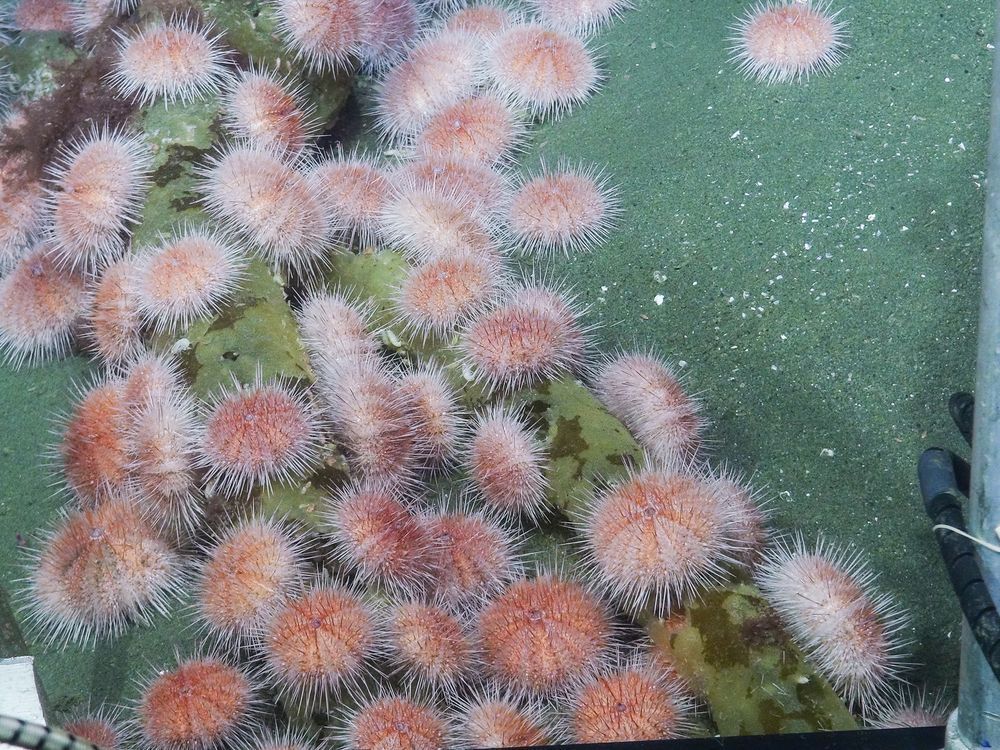“BC’s Pink Sea Urchins Take Refuge in Shallower Waters Due to Climate Change”
Breadcrumb Trail Links
“It’s almost like an indicator that things are changing fast and that’s important to people because that’s going to affect us too.”
In this image provided on February 7, 2023, a fragile pink sea urchin can be seen in the deep sea feeding on decaying algae during a 2016 expedition at the Endeavor site. Pink sea urchins like these are expanding their territory into BC’s shallower waters. Researchers say the movement is a sign of how rapidly climate change is affecting aquatic life. Photo by Ocean Networks Canada/WHOI/THE CANADIAN PRESS
content of the article
Pink sea urchins off the coast of Vancouver Island are spreading into shallower waters, which researchers say is an indication of how rapidly climate change is affecting ocean life.
advertising 2
This ad has not yet loaded, but your article continues below.
SIGN UP TO UNLOCK MORE ARTICLES
Create an account or log in to continue your reading experience.
- Access items from across Canada with one account
- Share your thoughts and join the discussion in the comments
- Enjoy additional articles per month
- Receive email updates from your favorite authors
content of the article
Researchers from Memorial University, Ocean Networks Canada and the University of Victoria found that the sea urchins, which live up to 400 meters deep, are expanding their populations into shallower waters at an average rate of 3.5 meters per year as the warming ocean reduces oxygen levels and the food sources diminished at shallower depths.
By clicking the subscribe button, you agree to receive the above newsletter from Postmedia Network Inc. You can unsubscribe at any time by clicking on the unsubscribe link at the bottom of our emails or any newsletter. Postmedia Network Inc | 365 Bloor Street East, Toronto, Ontario, M4W 3L4 | 416-383-2300
Thanks for registering!
content of the article
Study co-author Rylan Command said that thermal domes and heat waves are becoming more common and that understanding how the ocean responds to these changes can have a direct impact on people.
The movement of pink sea urchins over time, for example, could upset the balance with other sea creatures and cause them to replace other species like the red sea urchin harvested in fisheries, he said.
“It’s almost like an indicator that things are changing fast and that’s important for people because that’s going to affect us, too,” he said.
advertising 3
This ad has not yet loaded, but your article continues below.
content of the article
The researchers looked at 14 years of data, including before, during and after the ocean heatwave known as “The Blob,” which lasted in the Pacific Ocean between 2013 and 2016.
They used data from both an Ocean Networks Canada observatory and the Federal Fisheries and Oceans Trawl Survey to gather information from about 400 meters deep, covering an area of 760 square kilometers.
“We were able to get a holistic picture of how everything is changing. I think this kind of data combination is really important and really useful,” Command said.
Study co-author Fabio De Leo, who works at UVic’s Oceans Network Canada, said that warming from The Blob destroyed much of the kelp that the sea urchins eat, leading to a dramatic decline in their populations.
advertising 4
This ad has not yet loaded, but your article continues below.
content of the article
“The algal forests felt the ocean heatwave quite badly. So that’s essentially one of the main foods for the pink sea urchin,” he said.
The researchers say the higher-than-average surface temperatures also disrupted the ocean process known as “upwelling,” which sees nutrient-rich water rushing to the surface from deeper depths and potentially affecting where the sea urchins find food.
The BC research aligns with similar work done in California in 2017, which found that pink sea urchins also sought out shallower waters in that region.
De Leo said it’s important for monitoring the area to have data that spans more than a decade.
“We need to know how biodiversity and marine communities are changing over time in order to adapt and make plans,” he said.
Share this article on your social network
Display 1
This ad has not yet loaded, but your article continues below.
Comments
Postmedia strives to maintain a vibrant but civilized forum for discussion and encourages all readers to share their views on our articles. Comments may take up to an hour to be moderated before they appear on the site. We ask that you keep your comments relevant and respectful. We’ve turned on email notifications – you’ll now receive an email when you get a reply to your comment, there’s an update on a comment thread you follow, or when a user you follow comments follows. For more information and details on how to customize your email settings, see our Community Guidelines.
Don’t miss interesting posts on Famousbio










